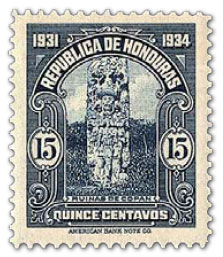
These two stamps were from Honduras in 1931. On the left top image, the 1931 stamp depicts a Mayan archeological site, a Mayan stele, or monument made of stone and located in Copán Ruinas, a city in Honduras.
On the other hand, the bottom stamp is also from 1931, but it features Christopher Columbus.

These are stark differences for the year 1931. One represents the history of the Mayan people pre-colonial contact, and the other image heroizes a colonizer, responsible for the death of millions of indigenous people. It shows the contrast between memorializing indigenous peoples of the past for their cultures and accomplishments but disregarding and disrespecting the indigenous peoples who have managed to survive the brutal and ravaging effects of colonization while honoring one of those responsible.
This is important to our course on Modern Latin America as well as themes and lessons on Latin America today because it is important to not conflate memorialization of indigenous peoples and infatuation of cultures with the respect for human life and modern indigenous communities. Even those who love ancient indigenous cultures have the potential to suppress the voices of indigenous people alive today, especially state governments. The state may claim ownership of the accomplishments and advancements of previous indigenous civilizations such as pyramids or other ruins, while actively suppressing the voices of modern indigenous communities and disenfranchising them.
Works Cited:
Anderson, S. (2017, October 10). Stamps of HONDURAS: Issues of 1931 (1243448325 922067439 W. Cochrane, Ed.). Retrieved March 11, 2021, from http://www.philatelicdatabase.com/united-states/stamps-of-honduras-issues-of-1931/
